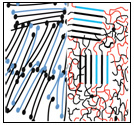The dramatic influence of polymer processing conditions on the performance of polymer solar cells is highlighted by a new paper in the Journal of Polymer Science: Polymer Physics.
The study resolves some of the discrepancies found between experimental results from previously published studies and highlights that processing and molecular weight need to be carefully controlled to ensure maximum solar cell performance.

Teams led by Natalie Stingelin from Imperial College, London and Garry Rumbles from the National Renewable Energy Lab in Boulder, Colorado collaborated on the work to study the generation of charge carriers in neat poly(3-hexylthiophene) (P3HT) solar cells and how it depends on the polymer solid-state microstructure. They are able to control the morphology from stacked, non-entangled chains in low-molecular-weight P3HT through to mixed stacked and amorphous, entangled phases in samples with higher molecular weight. The researchers find that it is easiest to separate charges when there are both crystalline and amorphous regions.
In previous studies on P3HT, other researchers have found yields of free charges appearing after photoexcitation can vary enormously between 1% and 15%; this work reveals that different polymer microstructures could account for that variation.
Obadiah G. Reid, Jennifer A. Nekuda Malik, Gianluca Latini, Smita Dayal, Nikos Kopidakis, Carlos Silva, Natalie Stingelin, and Garry Rumbles, "The influence of solid-state microstructure on the origin and yield of long-lived photogenerated charge in neat semiconducting polymers", J. Polym. Sci. Part B: Polym. Phys., 2011, DOI: 10.1002/polb.22379.
This article is available online at http://onlinelibrary.wiley.com/doi/10.1002/polb.22379/abstract.